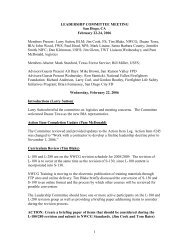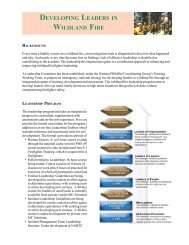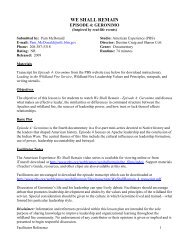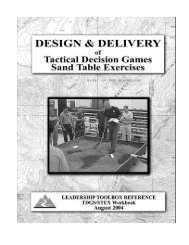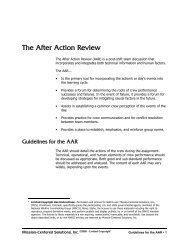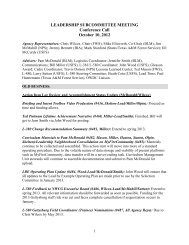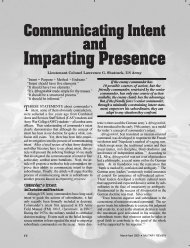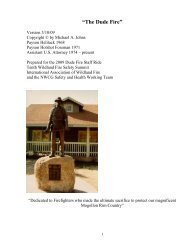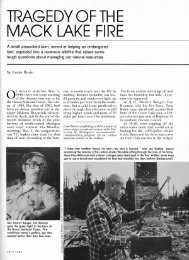Sadler Fire Staff Ride - Wildland Fire Leadership Development
Sadler Fire Staff Ride - Wildland Fire Leadership Development
Sadler Fire Staff Ride - Wildland Fire Leadership Development
Create successful ePaper yourself
Turn your PDF publications into a flip-book with our unique Google optimized e-Paper software.
2011Participant GuidePrepared by GabrielDonaldson and CraigCunningham[SADLER FIRE STAFF RIDE]
<strong>Sadler</strong> <strong>Fire</strong> <strong>Staff</strong> <strong>Ride</strong>Pre-Work:Prior to participating in the <strong>Sadler</strong> <strong>Fire</strong> <strong>Staff</strong> <strong>Ride</strong>, students should read the <strong>Sadler</strong> <strong>Fire</strong>Investigation and Incident Action Plan which can be found at:www.wildfirelessons.net/documents/1999_sadler_report.pdfPlease read and review the 6 Minutes for Safety from August 9 th , 2010:http://www.wildfirelessons.net/uploads/6mfs/home.htmlStudents are also encouraged to read the “Ghosts of Storm King” in John Maclean’sBook <strong>Fire</strong> and Ashes to gain a different perspective of the events surrounding the<strong>Sadler</strong> <strong>Fire</strong> Entrapment. Please bring a copy of the Incident Action Plan, IncidentResponse Pocket Guide and <strong>Sadler</strong> <strong>Fire</strong> Investigation with this Participant Guide to the<strong>Staff</strong> <strong>Ride</strong>.Please pack a lunch, dress appropriate for the weather conditions and anticipateabout a 2.5 mile round trip hike over moderately level terrain. Participants shouldplan to carpool in order to reduce traffic to and from the <strong>Sadler</strong> site.*******************************************************************Outline:0700-0715: Introductions (Elko District Office Conference Room)0715-0900: <strong>Sadler</strong> <strong>Fire</strong> Summary PowerPoint (Conference Room)RHA’s (Conference Room)Stand #1 (Conference Room)Pre-Mortem (Conference Room)0900-1015: Travel to the “Big Safety Zone”1025-1230: Travel to the “Y” (Stand #2)Hike Stands #2-#51230-1345: Travel from the “Y” to Elko1345-1500: Stand #6 (Classroom)AARLessons Learned/IntegrationPage | 2
<strong>Sadler</strong> <strong>Fire</strong> <strong>Staff</strong> <strong>Ride</strong>Acknowledgments/Credits:Gabriel Donaldson: Facilitator/ participant guide formatting, PowerPoint presentationpreparation; stand outlines/formats, facilitation and integrationWilliam (Craig) Cunningham: Participant guide formatting, map formatting, facilitationand integrationShane McDonald: Research, interviews, site preservation, document preservationTom Warren: Site preservationSteve Dondero: Air Attack Summary, aerial organization information, general commandoverview, VHS footage.Jeff Arnberger: Networking, command overviewDylan Rader: General assistance, command and situation informationMatt Murphy: MapsGerry Beddow: Pictures, unit logsRuby Mountain Hotshot <strong>Staff</strong>: Setting up field stands, welding stand displays (AlexLemelin)Tom Turk: VHS FootageEric Allen: Northern Nevada Situation Map, <strong>Sadler</strong> Complex Map, <strong>Fire</strong> History Report.All contributor’s to the Investigations Report, John Maclean and hisauthorship of the “Ghosts of Storm King” (<strong>Fire</strong> and Ashes).Page | 3
<strong>Sadler</strong> <strong>Fire</strong> <strong>Staff</strong> <strong>Ride</strong>Map of Focus Area/ Dozer Line and Entrapment Site (In Black):Page | 4
<strong>Sadler</strong> <strong>Fire</strong> <strong>Staff</strong> <strong>Ride</strong>Stand #1: “ORGANIZATION: THE CREW AND THE COMMANDSTRUCTURE”Crew Summary: Golden Gate National Park #3 (GNP #3) is assembled in San Francisco, CA torespond to an incident in Elko County near Jiggs, NV. Comprised of 21 individuals, the crewparticipates in one training hike prior to a late afternoon departure for the Elko area. The GNP#3 is a mixed bunch of individuals who do not regularly work with each other (a regular crew orad hoc crew). The CRWB and Trainee disagree on a plan to travel to the fire, with the two beingseparated by nearly a day. The Crew Boss does not honor his plan to rest overnight inWinnemucca, NV but pushes all the way through to the incident, leaving his trainee in doubt ashe and a different driver stay in Winnemucca as initially planned.Upon arrival at the fire the Crew Boss, Horton, goes on a scouting mission; Naar (CRWB-T)arrives and through consistently poor communication a “search party” request is put in to findHorton; a helicopter announces Horton as “missing” over an A-G frequency; when Horton isretrieved Naar and Horton have a heated exchange.Command Summary: The fires in Northern Nevada were growing fast and combining. Theactivity, size and complexity of the fires prompted the birth of the “<strong>Sadler</strong> Complex”. August 9 thdid not start off well; the organization was disjointed and due to a number of factors, includinga recent team transition, resources were confused about their assignments. Many resourcesdidn’t receive an Incident Action Plan and many missed out on some very importantinformation, including a critical weather update for the fire area, “The minimum RH wasexpected to be 6 to 12 percent, and a Haines Index of 6 was forecast. Fine fuel moisture wasexpected to be 3 percent.” The morning briefing in Jiggs was announced by Dan Huter and manyresources didn’t hear or know that the meeting was occurring; missing critical pieces ofinformation. The Incident Action Plan indicated a lack of adequate fire line supervisors,displayed by Tom Shepard being listed as the Division Q and Division O supervisor. There wasan obvious disconnect between planning and operations, as Branch Directors were tasked withcreating their own Branch plans, not to mention the fact that Branch II’s organization hadbecome vague: “In the IAP, the northeast part of the fire was shown as two divisions - O, underShepard, and Q, under Mike Head. At some point, that was changed to one division - - Q - - withShepard as division supervisor. There was confusion throughout the day on Branch II overdivision locations, assignments, and chain of command.”Page | 5
<strong>Sadler</strong> <strong>Fire</strong> <strong>Staff</strong> <strong>Ride</strong>Stand #1-Organization: Tactical Decision Games (TDGS)You have been tasked with mobilizing a crew in San Francisco, California, travelling to Nevadaand working on a fire in Jiggs, Nevada. You’re crew is comprised of regular employees with aneclectic set of backgrounds, some of whom have never fought a fire. You have been assigneda Crew Boss Trainee, and it has been requested that you leave as soon as possible.As the Crew Boss for the GNP #3 crew, conduct a pre-mortem which addresses mobilization, travel, suppression,demobilization and return travel to San Francisco.What tools are available to us to aid in a safe, timely and effective mobilization and departure?As the Crew Boss what would be your priority with this new crew? How are you going to ensure that you focus onthat priority?Is two way communication flow necessary for a Crew Boss and Crew Boss Trainee to effectively interact with eachother? How could you, as a Crew Boss Trainee, effectively communicate concerns/ issues to your Crew Bosswithout inviting conflict? What could Naar and Horton have done to ensure that they were on the same pageconcerning travel to the incident and all future engagements?The Incident Response Pocket Guide was not a tool that was available to firefighters in 1999. What parts of theIRPG do we use on a day to day basis?Stand #1-Organization: Strategic Discussion Points (SDPS)It is 0600 on August 9 th of 1999 in Jiggs, NV. You are the Crew Boss for GNP #3, who hasdriven all night to arrive at an incident and are without your entire crew due to amiscommunication or lack of communication. You have worked a shift of the fire and areeager to become more involved in suppressing the incident. While attending the morningbriefing you did not receive an Incident Action Plan, but hear talk of Red Flag Warnings andextreme fire behavior.Assuming that you want to work on the fire, what information needs to be clarified prior to engaging or eventraveling to your division assignment?Considering the Incident Command Structure and interface of elements within it, what areas of the ICS are failingat this point in the incident? How might a Branch Director, Division Supervisor, Operations Section Chief or even anIncident Commander mitigate and/or draw attention to these failures? What strong reaction would you take (as afire line supervisor) to a seemingly weak signal that the organization is crumbling?As the Crew Boss do you feel that you could safely engage a division of the fire at this time? Why? Why not?Stand #1-Organization: High Reliability Organizing (HRO)What other tool do we have to consider while trying to safely and reliably organize, manage and engage all aspectsof wildland fire? Are there “small failures” which need to be addressed/ tracked, prior to arrival at the IncidentCommand Post which has already occurred?Page | 6
<strong>Sadler</strong> <strong>Fire</strong> <strong>Staff</strong> <strong>Ride</strong>Stand #2: “FIRING PLANS AND THE ‘Y’”Summary: Shepard (DIVS) briefed crews at the “Big Safety Zone” approximately 2 miles fromthe “Y” regarding a plan to burnout out a series of roads and dozer lines. Shepard haddeveloped this plan with Huter (Branch Director), but it had not been fully developed. The “Y”was located about 2 miles north from the “Big Safety Zone” and from the “Y” a dozer line wasbeing completed and tying in with the “Big Black”, an recently burned area which would havesufficed as an anchor point or tie in point. The original plan was to burn from the “Big SafetyZone” to the “Y” and from the “Y” to the “Big Black” utilizing the two hotshot crews (SmokeyBear and Dalton) with GNP #3 in support. The Hotshot Crews were “. . . reluctant to initiate thatplan until the eastern flank south of the Big Safety Zone was secured.” Superintendents RichDolphin (Smokey Bear) and Neil Metcalf (Dalton) continued to scout options in and around the“Big Safety Zone” while more resources arrived on Division Q, “Shepard reported beingswamped at this time by radio traffic, the number of resources reporting, the number ofresources just turning up, and problems with dozer fueling. Operations were delayed in part bythe heavy workload he faced.” (From page 9-10 of the Investigation Report)Shepard had Dozers improving safety zones and creating new ones. The northern dozer line hadbeen put in the evening of August 8 th . There were, all told, 6 safety zones of approximate equalspacing between the “Y” and tie in point to the west (the investigation notes spacing of 1370feet. Our maps and research shows the “Y” as a safety zone plus 4 between the “Y” and CP-11.CP-11 abuts the “Big Black” which is in and of itself a large safety zone). The proposed tie inpoint was an old burn referred to as the “Big Black” While the "Big Black" was going to beutilized as a potential tie in point, "The 'Big Black' was an old burn not recent, or not from<strong>Sadler</strong> anyway. 1 " The proposed burn spanned a distance of approximately 1.3 miles.At the “Big Safety Zone” on the morning of the 9 th , Smokey Bear IHC, together with Dalton IHCdetermined that if the burn was to be conducted, burning from the Y going west was not agood option. Smokey Bear IHC had been working the east flank for several days prior to the 9 th ,observing consistent runs at 1100 each day, and a lack of adequate personnel to conduct alarge scale burning operation. If the burn was going to be conducted, it would need to bestarted at an anchor point to the south on the east flank: "It was a combination of safety andsound tactics that required the decision to anchor and secure the east side first. We had beenlosing line for a week due to resources being spread too thin and not being able to secure linebehind fast enough or trying to secure things too fast . . . The fuel load on the east flank washigh (old growth sagebrush) compared to the dry lake to the north.” Dalton and Smokey BearIHC’s together with Shepard and Frank finalized a plan to anchor and burn from a finger whichhad hit the Crane Spring road roughly 1.5 miles south of the “Big Safety Zone”. Dalton IHCproceeded north towards the “Big Safety Zone” while Smokey Bear IHC burned from the CraneSprings finger to the south for approximately 2 miles: “We began burning the east flank andwere already (1100) getting spots across to the east until a more consistent wind and the draw1 Rich Dolphin, Superintendent Smokey Bear IHC in email correspondence dated 3.13.2011.Page | 7
<strong>Sadler</strong> <strong>Fire</strong> <strong>Staff</strong> <strong>Ride</strong>of the burn helped reduce spotting. Afternoon runs were of the intensity that being at thehead without a solid anchor and line behind tied in, the work would be out flanked to the east.”Smokey Bear IHC Superintendent, Rich Dolphin, tied in with Dalton IHC near the end of the day,to discover that the burning operation on the east flank had been tied into the “Y”, he observedthat there was black to the west along the dozer line and S.E.A.T.’s were dropping on fireactivity to the west of the “Y”.Horton arrived at the Big Safety Zone after the meeting of the two Hotshot Crews and DivisionSupervisor’s. According to Dolphin: “I do not think Horton was clearly informed that the IHCs haddone something different and why 2 ", uninformed by Shepard that the IHC’s were burning severalmiles to the south of the “Big Safety Zone”. Conversely, according to Dolphin, the IHC’s had “noidea the GNP crew was out there burning the dozer line”.The plan established by Shepard and GNP #3 was for Horton, Deaton, Christensen and Hyde toanchor their burn from the black finger to the west towards the “Y”. After a briefing at 1400,they opted to return to the “Y” and burn to the west due to changing winds. Firing operationsbegan at 1500, with the remainder of the GNP #3 crew staying at the “Big Safety Zone”. Engines3636 and 3639 would aid in holding operations.Stand #2-Firing-Tactical Decision Games (TDGS)The Lucky Nugget Subdivision is a resource of concern to the Team managing the <strong>Sadler</strong>Complex. There is a large portion of unsecured line between the “Big Black” and the “BigSafety Zone” which, if left unchecked could make a run towards the subdivision. The IncidentObjectives for the <strong>Sadler</strong> Complex were: “1) <strong>Fire</strong>fighter and public safety; 2) Protection ofstructures; 3) Suppression of the fire in the most cost-effective manner; 4) Protection ofhistoric cultural sites; 5) Protect archeological sites in Aiken Canyon and Mineral Hill; 6)Protect livestock.”As the Crew Boss, do you think there is a feasible method for securing the line between the “Big Black”and the “Big Safety Zone”? Keep in mind the Incident Objectives and that conditions do not warrant asafe direct attack tactic at this time.As a Crew Boss, what are your concerns with the proposed plans as they stand now?Keeping in mind that the Incident Response Pocket Guide was not a tool available to firefighters in 1999;what “watch-outs” are you observing? How will you mitigate them?Lookouts, Communications, Escape Routes and Safety Zones (LCES) are integral components in safelyfighting fire. Are they in place? Can you put them in place to safely engage?What other tool is available when considering risk in the fire environment?Who has ever had a “hazardous attitude”? How have you been able to mitigate that attitude or how areyou mitigating it now?2 Discussed in phone interview with Rich Dolphin, Superintendent Smokey Bear IHC; 3.17.2011.Page | 8
<strong>Sadler</strong> <strong>Fire</strong> <strong>Staff</strong> <strong>Ride</strong>Stand #2-Firing-Strategic Talking Points (STPS)According to local notes and observations by the Air Tactical Group Supervisors and Elko Managementthere was a priority to protect ranches and structures near the southern end of the Sulfur Springsmountain range (the southernmost part of the <strong>Sadler</strong> fire). Visibility of divisions O, N and Q from theair was null. The fire’s airspace was being shared by two Air Tactical Group Supervisors due to the sizeand complexity of the fire, but they were having issues communicating with the providedfrequencies 3 . Burning the northernmost part of the <strong>Sadler</strong> fire (the dozer line) was proposed as a longterm strategy only when there was a break in visibility (on the 8 th of August). The dozer line was put inthe night prior to being burned and there was a forecasted cold front predicted for the 10 th of August.As an outgoing member of the Type 2 organization either demobilizing from the fire or transitioning intoanother role, how critical is disseminating strategic information from shifts prior? Some people tend tobelieve that they can start with a fresh slate when organizing an ongoing incident, is there value in reorganizingand omitting previous strategic plans? Was there an imminent need to conduct a burn-out atthe northernmost division of the <strong>Sadler</strong> <strong>Fire</strong> on this division on August 9 th ?The Incident Action Plan for the 8.9.99 day shift shows Dalton IHC, Smokey Bear IHC and GNP #3assigned to Division “N” (Chuck Frank). Due to a vehicle failure en route to the “Big Safety Zone”Horton (GNP #3) was unaware of the plan which was established by Frank, Shepard, Smokey Bear IHCand Dalton IHC. GNP #3 was assigned an operation on an adjoining Division Q (Shepard). Resourcescontinued to arrive and Shepard was “swamped at this time by radio traffic, the number ofresources reporting, the number of resources just turning up . . .”How could the team have mitigated potential span of control issues?Contrasting our knowledge of fire operations today what large scale strategic steps could havebeen taken to effectively manage the influx of resources relative to the fire’s growth?Stand #2-Firing-High Reliability OrganizingAs the Crew Boss originally assigned to a division with 2 IHC’s, how might you “develop skills . . . that willallow for improvisation and action when a failure occurs” (Commitment to Resilience)?If you knew that there were other crews on this division with you what questions would you ask theHotshot Superintendents and others on the division to broaden your understanding of what ishappening and “defer to expertise”?It has been noted that there “. . . was a combination of safety and sound tactics that required thedecision to anchor and secure the east side first.” As a Division Supervisor, what signal (weak orstrong) might prompt you to adjust interim tactics and strategy? What other information would youneed and what questions would you ask of your resources to develop a plan?3 Air Attack information and northern Nevada situation information provided by Steve Dondero (Elko Air Attackduring the <strong>Sadler</strong> Complex) and Jeff Gardetto (Air Support Group Supervisor on Ed Storey’s Type 1 Team); northernNevada situation information provided by Jeff Arnberger (<strong>Fire</strong> Operations Specialist during the <strong>Sadler</strong> Complex)Page | 9
<strong>Sadler</strong> <strong>Fire</strong> <strong>Staff</strong> <strong>Ride</strong>The “Big Black”Safety Zones, “Big Black” and the “Y”:CP-11Safety Zone #4Safety Zone #3Safety Zone #2Safety Zone #1The “Y”Page | 10
<strong>Sadler</strong> <strong>Fire</strong> <strong>Staff</strong> <strong>Ride</strong>Page | 12
<strong>Sadler</strong> <strong>Fire</strong> <strong>Staff</strong> <strong>Ride</strong>Stand #3-Firing from the Y-Tactical Decision Games (TDGS)While conducting this burning operation, it was noted in the Investigation that there washeavy radio traffic on Command and the Tactical Frequency. Horton’s crew was utilizing theirown crew net to communicate between each other and those participating in the burningoperation couldn’t or didn’t hear any critical radio traffic regarding an increase in fire activity.As a lookout, field observer or unassigned division supervisor asked to keep “an eye on theburn” what information do you need to convey to Horton? What should Shepard have clarifiedto his division resources regarding the request for Joe Reyes and Bob Hawkins to be his informallookouts? What should Shepard have made clear to Joe Reyes and Bob Hawkins?If you were an assigned lookout in this situation, how would you have mitigated the need tocommunicate critical information to the resources conducting the burnout? Keep in mind thatthe radio traffic is heavily clogged.As the Crew Boss and primary contact for the burning operation what is your task, purpose andend state for this particular project. Assuming you have an adequate anchor point to burn offof, how will you convey your leader’s intent to those who will be burning for you?As a Crew Boss, identify “trigger points” for stopping your operation.Stand #3-Firing from the Y-Strategic Discussion Points (SDPS)Referencing the Incident Response Pocket Guide, re-evaluate the:Risk Assessment ProcessThe 10 and 18LCESOperational <strong>Leadership</strong>Communication ResponsibilitiesLeader’s IntentHuman Factor Barriers to Situation AwarenessWhat’s missing? What’s present?Stand #3-Firing from the Y-High Reliability Organizing (HRO)Considering the full spectrum of information and guidance an HRO template provides what isdestroying the safety culture, pillars or foundation of an HRO?Is everybody on this division operating under a “reporting culture?” What barriers arepreventing this from occurring?Page | 13
<strong>Sadler</strong> <strong>Fire</strong> <strong>Staff</strong> <strong>Ride</strong>Stand #4: FIRING UNTIL ENTRAPMENTSummary: The GNP #3 crew is at the apex of the time wedge with each member of the firingoperation immersed in their respective duty. Communication is failing and fire behavior isextreme: “At about 3:40 p.m. Huter, dozer bosses Jim Allen and Gerry Beddow were watchingthe backfire operation from about three tenths of a mile to the west of the squad. As the mainfire became visible near the firing squad, these three people saw a fast moving ‘river of fire’ takeoff down from the hills toward the dozer line and squad.” Despite the efforts of Dan Huter(Branch Director) to contact the crew, he still had no response. The fire sent a fire whirl acrossthe fire line which cut Engine 3636 off from the crew; the engine retreated to a safety zone.Several spot fire were formed, the crew discussed trying to put the spot fires out, Horton urgedthem to “. . .go, go, go!”. The squad continued firing, cut off from Engine 3636 and the previoussafety zones identified on the dozer line, at 1540, the order was given by Horton to “Go, go, gorun!”Page | 14
<strong>Sadler</strong> <strong>Fire</strong> <strong>Staff</strong> <strong>Ride</strong>Stand #4: ENTRAPMENT/ CHECKPOINTS 1-11Checkpoints 1-11 highlight the area from where the firing squad was overrun to theconsequent burn over. The fire whirl is marked as CP 1a and isn’t identified as a Checkpoint inthe investigation. The “Big Black” is located at the fence line to the west. Please referencefigure 4 and the correlating checkpoint legend and distances. Pictures #1 through Picture #4show the fire advancing towards the dozer line and were taken from around the “Big Black”and/or Checkpoint 11. The Branch Director is pictured with the Chevrolet.Page | 15
<strong>Sadler</strong> <strong>Fire</strong> <strong>Staff</strong> <strong>Ride</strong>Stand #4-Firing until Entrapment-Tactical Decision Games (TDGS)Within this Division or in cooperation with other Divisions, what are some other tacticalchanges that could have taken place to address this part of the fire?Would changing the lighting technique or pattern have made any difference in the success orfailure of this burning operation? How?What of the 10 Standard <strong>Fire</strong>fighting Order and 18 Watch-Out Situations should be mitigated bythe time Horton yells, “Go, go, go, run!”Stand #4-Firing until Entrapment-Strategic Decision Points (SDPS)It is good practice to find alternative options to plans in the Risk Management Process. Takinginto account your knowledge of the Division, how could the general strategy have beenadjusted in the IAP to safely address the values at risk?By adjusting strategy, how could Division resources have been organized to address the valuesat risk without compromising firefighter and public safety?Stand #4-Firing until Entrapment-High Reliability Organizing (HRO)Included in the Principles of High Reliability Organizations is (1) preoccupation with failure (2)reluctance to oversimplify and (3) sensitivity to operations.What failures could have been corrected during the firing operation?Was there an attempt to simplify this operation? What were the errors in oversimplifying?What “strong response” could have been made to the increased fire behavior, lack ofcommunication, negligence of LCES?Page | 17
<strong>Sadler</strong> <strong>Fire</strong> <strong>Staff</strong> <strong>Ride</strong>FIRING TIMELINE:1100: Dolphin and Metcalf Return from Reconaissance.1300: Huter and Shepard decide on firing from the "Big Black" to the "Y"1400: GNP#3 Safety Brieing at the "Big Black"1430: Horton, Deaton, Christensen and Hyde change their starting point to the "Y".1500: Backfiring begins from the "Y" heading west1515: Spot fires across line, E3636 request that firing stop1530: Naar and Giampaoli are dropped off with firing squad by NDF Engine near SafetyZone #2.1540: Huter and 2 Dozer Bosses watching backfiring operation "river of fire"1540: Events and conditions have aligned for the entrapment.Page | 18
<strong>Sadler</strong> <strong>Fire</strong> <strong>Staff</strong> <strong>Ride</strong>Stand #5: THE SAFETY ZONE (BIG BLACK)It was evident that an entrapment had occurred, and it has also been noted that if it weren’t fora sudden wind shift the chances of survival would have been greatly diminished. Following theentrapment, the involved parties gathered at the “Big Black”: “The six crew members, feelingthe safety zone was too small, ran down the dozer line to Huter’s location. Huter inquired aboutinjuries and finding that Naar was an EMT, he instructed Naar to take charge of EMT duties andto administer oxygen from his trauma kit. Some of the crew members were coughing severely.Huter gave his vehicle to Horton to drive himself and the five crew members to the west end ofthe dozer line, where they joined the 15 other crew members of the GNP3 crew. About 4:00p.m., Huter called for a helicopter medical transport of the crew . . . Christensen and Giampaoliwere flown by helicopter directly from the line to the ICP for initial treatment. From there theywere taken by ambulance to the hospital in Elko where they were treated for second-degreeburns and smoke inhalation. The other 19 crew members were flown by helicopter to IndianWell and then to Jiggs camp. From Jiggs, they were taken by bus to the Elko hospital whereHorton, Naar, Hyde, and Deaton were examined and treated for smoke inhalation.Christensen, Giampaoli, and Naar were kept overnight in the hospital for observation while therest were released and billeted in a motel. Storey notified the Elko BLM Agency Administrator ofthe hospitalizations about 8:00 p.m.Christensen, Giampaoli, and Naar were released from the hospital on August 10, 1999, andwere expected to recover fully. They rejoined the rest of the crew at the motel in Elko to await acritical incident stress debriefing session.”The IHC's on this Division had no idea that the burnout of the Dozer Line was being conductedsimultaneous with other division operations, and noted that the shelter deployment wasn’teven mentioned in the following days briefing at the Jigg's Spike Camp 4 .Stand #5- The Safety Zone -Tactical Decision Games (TDGS)You are the Task Force Leader for a Division conducting a burnout operation. You are notifiedthat burn injuries have been incurred by members of a squad from a Type 2 crew, includingthe crew boss.What needs to be done to begin patient treatment and what protocol do you need to follow?As an incoming Task Force Leader arriving on this division of the <strong>Sadler</strong> <strong>Fire</strong>, what questionswould you be asking of the division supervisor? Of the resources assigned to you? How wouldeffectively integrate yourself into the existing organization and what issues would you address?4 Phone interview with Rich Dolphin, Superintendent Smokey Bear IHC on 3.17.11Page | 19
<strong>Sadler</strong> <strong>Fire</strong> <strong>Staff</strong> <strong>Ride</strong>Shortly following the burnover (20 minutes later) and subsequent burn injuries, a branchdirector (Huter) and dozer boss (Allen) completed the burnout which had ended a very shortdistance from the “Big Black”.As a task force leader assigned to this division and responsible for initial evaluation andtreatment of the burned individuals, do you feel that completing the burnout is mission critical?Would it be appropriate to interface with the Branch Director at this time and how would yougo about it?Stand #5-The Safety Zone-High Reliability Organizing (HRO)/ Strategic Decision Points (SDPS)HRO’s depend on a “reporting culture”; they depend on timely, transparent and accurateinformation to be conveyed. Sometimes we might wonder if we need to relay certaininformation and often times we decide that what we’ve observed or noted isn’t worthy ofbeing passed along. In the case of the burn injuries which were incurred during theentrapment, Ed Storey notified Elko BLM Agency Administrator of the hospitalizations at2000.When talking about the “Pillars” which support the “Safety Culture”, was the delay innotification due to communication failures? Was the notification made in a timely fashion?Considering that “just cultures . . . should be accountable for implementing a reliable operatingsystem and managing the workforce,” what needed to occur long before the incident in orderto ensure that a “reliable operating system” was in place?Page | 20
<strong>Sadler</strong> <strong>Fire</strong> <strong>Staff</strong> <strong>Ride</strong>Stand #6: INTEGRATIONThe events which followed the release of GNP #3 have not been chronicled in the same manneras the investigation of the entrapment. Integrating the lessons learned from the <strong>Sadler</strong> <strong>Fire</strong> isnot a onetime endeavor, but a piece of the continuous learning cycle. With the luxury ofhindsight an opportunity exists to look at the events and errors which occurred on August 9 th ,1999 outside of Jiggs, NV and make the judgment that “we would not make the samemistakes”. The <strong>Sadler</strong> <strong>Fire</strong> was one of many fast moving fires which outran not only the peopletrying to fight it, but the people trying to organize and manage it. Tools like the IRPG weren’tyet available, Critical Incident Stress Management (CISM) was a fairly new practice, Burn InjuryProtocols weren’t necessarily available and organizations (ICS, IMT, Working Groups, etc.)continued (and continue) to evolve. In order to live and work safely we have to accept that welive in an unsafe world, and that we must learn from mistakes.As students of fire we are obligated to learn from our mistakes and we are obligated toreinforce the practices that result in safe operations. We exist in a learning and competitiveculture which fixates on failure in order to breed a safer culture. The After Action Review is asimple and effective tool that is used to develop our knowledge and understanding of eventswhich have occurred. Combined with debriefings, pre-mortems, and briefings the AARreinforces our “learning culture”.Stand #6-The Safety Zone-IntegrationAs the Division Supervisor conduct an After Action Review with the resources on your Division:What was planned?What actually happened?Why did it happen?What can we do next time?Would there be any value in submitting a SAFENET after being a part of this incident? If you hadto choose one piece of the puzzle which contributed the most to this entrapment, what wouldit be and why?How will we apply the knowledge from today’s staff ride into our continued learning in the fireenvironment?What can we do during the pre-season to prepare ourselves, our co-workers and oursubordinates for a safe fire season?What actions can we take to reinforce positive action and correct weaknesses?Page | 21
<strong>Sadler</strong> <strong>Fire</strong> <strong>Staff</strong> <strong>Ride</strong>Evaluation (Please submit to Facilitator’s at the completion of today’s <strong>Staff</strong> <strong>Ride</strong>):* Constructive feedback is an integral part of the integration process and improving future facilitation.Were the Participant Guides sufficient? Do you have any suggestions on additions, omissions orareas in the guide which can be improved?Was the Facilitation of today’s <strong>Staff</strong> <strong>Ride</strong> appropriate? Did the facilitator’s adequately foster a“lessons learned” environment?Was the level of pre-course work too difficult? Too easy?Did the logistics and overall outline of today’s <strong>Staff</strong> <strong>Ride</strong> run smoothly? If not, please providesuggestions.Additional Comments:Page | 22



